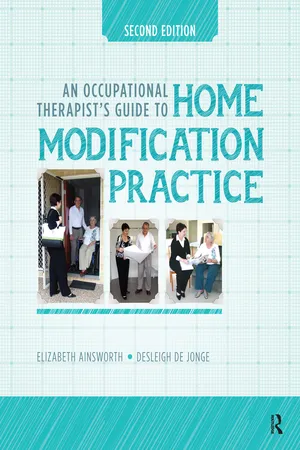
An Occupational Therapist’s Guide to Home Modification Practice
- 488 pages
- English
- ePUB (mobile friendly)
- Available on iOS & Android
An Occupational Therapist’s Guide to Home Modification Practice
About this book
Older people and people with a disability have a right to be included in all aspects of home and community life, and yet, environmental barriers continue to exist in the built environment. There are concerns about how well homes can support older people and people with a disability over time as their needs change.
Occupational therapists are well suited to determining the most appropriate home modification solutions to address environmental barriers. They possess the knowledge and skills necessary to evaluate people's current and future needs in the context of the nature and use of the environment and can work collaboratively with design and construction professionals to develop solutions.
To be comprehensive and effective in their approach, occupational therapists need to understand not only the individual's requirements, but also, the ethical and legal contexts for practice, the technical aspects of the built environment, the relevance and intent of access standards and design approaches, and the application of a range of products and finishes.
An Occupational Therapist's Guide to Home Modification Practice, Second Edition by Elizabeth Ainsworth and Desleigh de Jonge and their team of expert contributors provides comprehensive information to inform occupational therapists about current practice and research. This includes the authors using a transactional approach to examine the person-occupation-environment interaction and providing occupational therapists with a detailed understanding of the various dimensions of the home environment that can impact on client's home modification decisions.
New material has been provided relating to research and practice issues, such as an overview of the latest home modification outcome research findings as documented in literature; an update on outcome evaluation; new research information about the dimensions of the home impacting on decision making; additional information grabrail and ramp prescription; and the inclusion of new case studies illustrating minor and major modification solutions for clients who present with diverse needs.
In the Second Edition you'll find:
- A detailed understanding of aspects of the home environment that impact home modification decisions
- A review of legislative environment and funding systems that facilitate service delivery
- An overview of home modification services, as well as future trends
- A range of comprehensive case studies — illustrated by photographs
- Additional theory to inform knowledge, and skill development, that can be used in home modification practice worldwide
Included with the text are online supplemental materials for faculty use in the classroom..
An Occupational Therapist's Guide to Home Modification Practice, Second Edition provides a range of resources and tools, and it can be used as a teaching aid to support students, interns, and novice therapists or as a manual for reflection and practice for more experienced home modification practitioners.
Frequently asked questions
- Essential is ideal for learners and professionals who enjoy exploring a wide range of subjects. Access the Essential Library with 800,000+ trusted titles and best-sellers across business, personal growth, and the humanities. Includes unlimited reading time and Standard Read Aloud voice.
- Complete: Perfect for advanced learners and researchers needing full, unrestricted access. Unlock 1.4M+ books across hundreds of subjects, including academic and specialized titles. The Complete Plan also includes advanced features like Premium Read Aloud and Research Assistant.
Please note we cannot support devices running on iOS 13 and Android 7 or earlier. Learn more about using the app.
Information
Table of contents
- Cover Page
- Half Title page
- Title Page
- Copyright Page
- Dedication
- Contents
- Acknowledgments
- About the Authors
- Contributing Authors
- Preface
- Foreword
- Chapter 1 The Home Environment
- Chapter 2 Approaches to Service Delivery
- Chapter 3 Models of Occupational Therapy
- Chapter 4 Legislation, Regulations, Codes, and Standards Influencing Home Modification Practice
- Chapter 5 The Home Modification Process
- Chapter 6 Evaluating Clients' Home Modification Needs and Priorities
- Chapter 7 Measuring the Person and the Home Environment
- Chapter 8 Drawing the Built Environment
- Chapter 9 Developing and Tailoring Interventions
- Chapter 10 Sourcing and Evaluating Products and Designs
- Chapter 11 Access Standards and Their Role in Guiding Interventions
- Chapter 12 Ethical, Legal, and Reporting Variables Pathways to Best Practice
- Chapter 13 Evaluating Outcomes
- Chapter 14 Literature Review: Home Modification Outcomes for Older Adults and Adults With Disabilities
- Chapter 15 Case Studies
- Appendix A: Minor Modifications: It's Not as Simple as “Do It Yourself” (DIY)
- Appendix B: Outline of Shapes and Occupied Wheelchairs
- Appendix C: Fundamental Types of Compact Turns
- Appendix D: Ramp Installation Considerations
- Appendix E: Home Modification Practice Resources
- Appendix F: Access Standards Resources
- Appendix G: Home Visit Checklist
- Appendix H: Home Modification Report Template
- Appendix I: Example of an Occupational Therapy Report
- Financial Disclosures
- Index